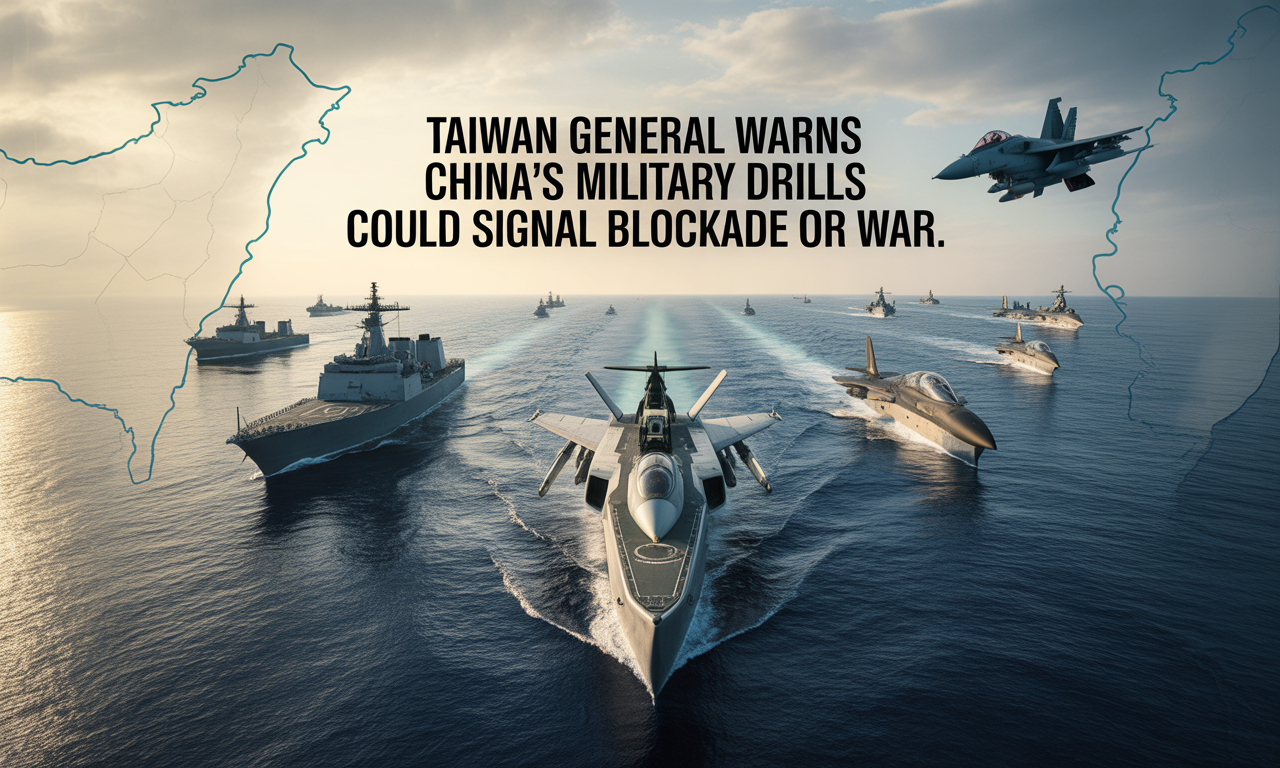Taiwan-China Military Drills Blockade Warning
Advanced | November 4, 2025
✨ Read the article aloud on your own or repeat each paragraph after your tutor.
A Strong Warning Amid Rising Tensions
Rising Military Pressure: Taiwan China Military Drills Blockade
On October 27, 2025, Sun Li-fang (Lt. Gen.), a senior officer of Taiwan’s armed forces, publicly warned that the neighboring People’s Republic of China (PRC) might use its ongoing military drills as a preparation for a blockade or outright war against Taiwan. This marks one of the strongest statements yet about the Taiwan China military drills blockade risk.
Blockade Seen as an Act of War
He emphasized that a blockade would be seen by Taipei as an “act of war,” urging Taiwan’s allies to treat it accordingly. (foxnews.com)
Taiwan’s military remains on high alert as the PRC continues to push its “anti-access/area-denial” strategy, aiming to limit foreign intervention and isolate Taiwan in a crisis. (foxnews.com)
What Exactly Is Taiwan Fearing?
From Drills to Combat Scenarios
Sun pointed out that what began as “training” missions could quickly transform into real combat operations if China chooses to escalate. He specifically mentioned concern about blockade tactics — intercepting shipping and air access to the island — as a plausible step before a full-scale invasion.
Vulnerability and Response Plans
Analysts say Taiwan’s geography and the complexity of its supply chains make it vulnerable to such a strategy. (foxnews.com)
Taipei says it has “holistic plans” to breach a blockade and has asked allies to view any full blockade as equivalent to war. (foxnews.com)
Why It Matters for Business and Global Trade
The Strategic Importance of the Taiwan Strait
The Taiwan Strait is a major global shipping route. A blockade of Taiwan would not only threaten Taiwan itself but could also disrupt international supply chains, including for semiconductors — a key industry for Taiwan and globally. The Taiwan China military drills blockade scenario would have massive economic ripple effects.
Business Implications
Sun underscored that allied support would be crucial in deterring such disruption. (foxnews.com)
For business professionals and investors, it’s a reminder that regional stability has direct implications for sectors like technology, manufacturing, logistics, and supply-chain risk management.
The Wider Military Context
Escalating Activity Around Taiwan
China has increased its military activity around Taiwan in recent years: frequent war games, air force sorties crossing the Taiwan Strait median line, and naval exercises near Taiwan’s outlying islands.
Taiwan’s Defensive Shift
Taiwan’s defense ministry states that these are not just drills but part of a larger “gray-zone” strategy designed to wear down Taiwan’s defenses without full-scale war. (focustaiwan.tw)
Taiwan, for its part, is shifting toward asymmetric defense capabilities — smaller, mobile systems, drones, dispersed command structures — aiming to offset China’s numerical and technological advantages. (foxnews.com)
What’s Next?
Long-Term Pressure Scenarios
Analysts suggest that while an immediate full-scale invasion still seems unlikely, Taiwan should prepare for sustained pressure, including blockades, cyberattacks, mine warfare, and supply disruptions.
Preparing for Resilience
Taiwan must also boost its resilience and ensure alliances are ready to respond. Sun’s public warning is partly strategic: it signals that Taiwan knows it must prepare and that it expects support from partners.
Business-wise, companies with ties to Taiwan or supply chains passing through the region should assess risk scenarios for disruption and monitor developments.
Vocabulary
- Blockade (noun) – the act of sealing off a place to prevent goods or people from entering or leaving.
- Example: “Taiwan fears a maritime blockade might cut off essential supplies.”
- Asymmetric (adjective) – not equal; in warfare, when a weaker force uses unconventional methods to counter a stronger force.
- Example: “Taiwan is focusing on asymmetric capabilities such as drones and mobile launchers.”
- Gray zone (noun) – a strategy in between peace and war, using coercion, harassment, cyberattacks rather than open combat.
- Example: “China’s gray-zone tactics aim to pressure Taiwan without triggering full war.”
- Deterrence (noun) – the act of discouraging an action by fear of the consequences.
- Example: “Taiwan wants its alliances to provide deterrence against a blockade.”
- Encirclement (noun) – surrounding a target so it cannot easily escape or receive reinforcement.
- Example: “The drills included exercises simulating encirclement of Taiwan’s islands.”
- Resilience (noun) – the capacity to recover quickly from difficulties.
- Example: “Taiwan is building resilience by diversifying supply routes.”
- Provocation (noun) – an action or statement that angers or incites someone into reacting.
- Example: “The military drills are seen as a provocation by Taiwan’s defense ministry.”
- Intervention (noun) – the act of becoming involved in something to change what is happening.
- Example: “Taiwan argues that allies must be ready for intervention if a blockade occurs.”
- Warranty (noun) – (in business) a guarantee; (in military/strategic use) a condition or promise supporting another action.
- Example: “Taiwan treats any blockade as a warranty of war-type response.”
- Red line (noun) – a point or limit that must not be crossed without serious consequences.
- Example: “Taiwan considers a full blockade a red line.”
Discussion Questions (About the Article)
- What specific warning did Lt. Gen. Sun Li-fang give, and why is it significant?
- How does Taiwan view a possible blockade differently from China’s military drills?
- Why are supply chains and shipping routes important in the context of the Taiwan-China situation?
- What is “asymmetric defense,” and how is Taiwan applying it?
- How can businesses use the information in this article to assess risk and plan ahead?
Discussion Questions (About the Topic)
- Should the international business community assign higher risk ratings to regions like the Taiwan Strait? Why or why not?
- How can a small country like Taiwan realistically deter a much larger neighbor?
- What role do alliances and external partners play in managing conflict-risk zones?
- How far should companies factor geopolitical scenarios (like possible blockades) into their supply-chain planning?
- When a country motivates its citizens and economy for resilience, what business and educational models support that effort?
Related Idiom
“Drawing a red line” — setting a clear boundary that must not be crossed without serious consequences.
Example: “Taiwan is drawing a red line: a full blockade would trigger war-level response.”
📢 Want more fun English tips like this? 👉 Sign up for the All About English Mastery Newsletter! Click here to join us!
Want to finally Master English but don’t have time for long lessons? Mastering English for Busy Professionals is designed for you — short, smart, and effective.
Follow our YouTube Channel @All_About_English for weekly lessons and quick English hacks!
This article was inspired by: Fox News (Oct 27 2025) (foxnews.com)


